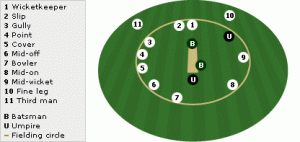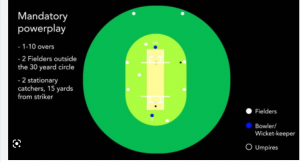What is a Powerplay in Cricket
What is a powerplay in cricket
In cricket, a powerplay is a period of play where certain restrictions are placed on the fielding team, making it easier for the batting team to score runs. In limited-overs cricket, such as One Day Internationals (ODIs) and Twenty20 (T20) matches, powerplays are used to increase the pace of the game and create more exciting cricket.
What is the Benefit of Powerplay in Cricket?
The benefit of powerplay in cricket is that it makes the game more exciting and fast-paced by providing an advantage to the batting team, allowing them to score runs more quickly and set challenging targets for the fielding team to chase. The powerplay rules are designed to create a balance between bat and ball, encouraging more aggressive and attacking cricket.

For the batting team, the powerplay provides an opportunity to score more runs and take control of the game early on in the innings. By having fewer fielders outside the 30-yard circle during the powerplay, batsmen can play more aggressively, hit more boundaries, and take advantage of gaps in the field.
For the fielding team, the powerplay provides an opportunity to take early wickets and restrict the scoring of the batting team. By using their best bowlers and fielders during the powerplay, they can put pressure on the batsmen and create chances to take wickets.
Overall, the powerplay in cricket adds a strategic element to the game, with teams often planning their batting and bowling strategies around the powerplay period. The success of a team during the powerplay can often determine the outcome of the match, making it a crucial period of play.
What is powerplay in ODI?
In ODI cricket, a powerplay is a period of play where certain fielding restrictions are in place to make it easier for the batting team to score runs quickly. In an ODI match, the first powerplay is mandatory and lasts for the first 10 overs of the innings.
During the first powerplay in ODI cricket, only two fielders are allowed outside the 30-yard circle, which is marked on the field. This means that the remaining fielders must be positioned within the circle, making it easier for the batting team to score boundaries and run quick singles.
The purpose of the powerplay in ODI cricket is to provide a balanced competition between bat and ball. The fielding team will usually try to take early wickets during the powerplay to restrict the scoring of the batting team, while the batting team will try to score as many runs as possible during this period to set a good foundation for the rest of their innings.
There are no further powerplays in ODI cricket, but there is a similar rule called the “batting powerplay” which was introduced in 2011 but has since been abolished.
The batting powerplay allowed the batting team to take a powerplay of five overs at any point between overs 16 and 40 of their innings, during which only three fielders were allowed outside the 30-yard circle.
However, this rule was scrapped in 2015 due to a lack of popularity and controversy over its impact on the game.
What is powerplay in T20?
In T20 cricket, a powerplay refers to a period of play where certain fielding restrictions are in place to make it easier for the batting team to score runs quickly. In T20 matches, there are two powerplays: the mandatory powerplay, which lasts for the first six overs of the innings, and the optional powerplay, which can be taken by the batting team between overs 7 and 15.
During the mandatory powerplay, only two fielders are allowed outside the 30-yard circle, which is marked on the field. This means that the remaining seven fielders must be positioned within the circle, making it easier for the batting team to score boundaries and run quick singles.
The optional powerplay, which can be taken by the batting team at any point between overs 7 and 15, is similar to the mandatory powerplay, but only four fielders are allowed outside the 30-yard circle. This makes it even easier for the batting team to score quickly and set a challenging target for the fielding team.
Powerplays are a crucial period in T20 cricket, as they can often determine the outcome of the match. The batting team will usually try to score as many runs as possible during this period, while the fielding team will try to take wickets and limit the damage.
What is a powerplay ? The Hundred
The Hundred is a new format of cricket that was introduced in 2021, and it also features a powerplay. In The Hundred, the powerplay is a period of 25 balls where the fielding team is allowed to have only two fielders outside the 30-yard circle. This is similar to the powerplay in T20 cricket, but with a longer duration.
The powerplay in The Hundred takes place at the start of each innings, with the first 25 balls of the innings being designated as the powerplay. During this period, the batting team is expected to score as many runs as possible, while the fielding team will try to take early wickets and restrict the scoring.
After the powerplay, the fielding team can position their fielders anywhere on the field, but the batting team can still take advantage of the remaining fielding restrictions, such as the maximum of five fielders allowed outside the 30-yard circle in the last 20 balls of the innings.
The powerplay in The Hundred is designed to make the game more exciting and fast-paced, with the shorter format and longer powerplay period allowing for more aggressive and attacking cricket. It is a crucial period of play, and the success of a team during the powerplay can often determine the outcome of the match.
T20 Powerplay Rules
In T20 cricket, powerplay rules are designed to make the game more exciting and fast-paced by providing an advantage to the batting team. There are two powerplays in T20 cricket: the mandatory powerplay and the optional powerplay.
- Mandatory powerplay: The mandatory powerplay lasts for the first six overs of the innings. During this period, only two fielders are allowed outside the 30-yard circle, which is marked on the field. This rule is intended to make it easier for the batting team to score runs quickly and set a challenging target for the fielding team.
- Optional powerplay: The optional powerplay can be taken by the batting team at any time between overs 7 and 15. During the optional powerplay, only four fielders are allowed outside the 30-yard circle. This rule is intended to give the batting team a further advantage and help them to score even more runs quickly.
It’s worth noting that each team is only allowed one optional powerplay during their innings, and they must inform the umpire before the start of the over in which they wish to take the powerplay. If they fail to do so, the umpire will not allow them to take the powerplay.
Overall, powerplay rules in T20 cricket are designed to encourage more aggressive and attacking cricket by providing an advantage to the batting team. The success of a team during the powerplay period can often determine the outcome of the match.
ODI Powerplay Rules
In ODI cricket, powerplay rules are also designed to make the game more exciting and fast-paced by providing an advantage to the batting team during certain periods of the game. There is only one powerplay in ODI cricket, which is the mandatory powerplay.

Mandatory powerplay: The mandatory powerplay lasts for the first 10 overs of the innings. During this period, only two fielders are allowed outside the 30-yard circle, which is marked on the field. This rule is intended to make it easier for the batting team to score runs quickly and set a challenging target for the fielding team.
After the mandatory powerplay, the fielding team can position their fielders anywhere on the field, but the batting team can still take advantage of the remaining fielding restrictions, such as the maximum of four fielders allowed outside the 30-yard circle in the last 10 overs of the innings.
Overall, the powerplay rule in ODI cricket is designed to encourage more aggressive and attacking cricket by providing an advantage to the batting team during the early stages of the innings.
The success of a team during the powerplay period can often determine the outcome of the match, and teams often try to maximize their runs and wickets during this period to set a competitive target or chase down a total.





